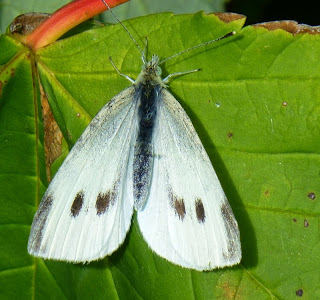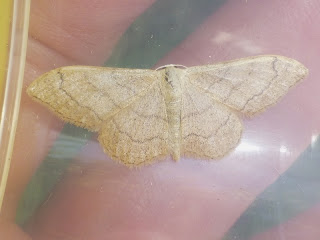I duly ordered a new electrics set which arrived within 24 hours of ordering (well done NHBS and Royal Mail!) and I had the trap up and running overnight on the 27th/28th July. By this time the heatwave had come to an end and so I had missed most of the best moth trapping weather I have ever known but it was at least still warm and humid overnight. On checking the trap I had the usual suspects for the time of year with 3 coronets (one of my favourite moths) and 16 male and 9 female (!) four spotted footman being the highlights.
Coronet
Female Four Spotted Footman
Male Four Spotted Footman
Monday 29th July and with the day off I decided to head off to Dawlish Warren for the day. It was warm and humid but breezy and with some heavy showers but I managed to dodge most of them. I set myself the target of seeing 3 species, the same as my birthday trip to Dunsdon - a butterfly, an orchid and a bird.On arrival at Dawlish Warren I headed off straight away to the hide to catch the high tide roost, noting quite a few butterflies along the way - gatekeeper, meadow brown, speckled wood, small skipper, small white, large white, small copper and common blue. A quick detour and I found my target orchid species, a marsh helleborine, which was beginning to go over.
Large White
Marsh Helleborine
Arriving at the hide, there was a large flock of oystercatcher and dunlin congregating to roost as the tide came in and amongst them were a turnstone in summer plumage, a sanderling, 3 ringed plover and 4 whimbrels. 2 little egrets and a juvenile Mediterranean gull added an exotic air. A large group of very noisy Sandwich terns were also roosting in front of the hide including quite a few juveniles, some sporting leg rings from a ringing program in The Netherlands. Interestingly the adults would fly in with sand eels, calling their fledgling to fly to the water where the fish would be passed over as they sat on the water, no doubt to minimise the risk of the fish being stolen by the marauding herring gulls.While watching the terns my second target species appeared, an adult roseate tern, flying in to roost amongst the Sandwich terns and later joined by a second bird complete with a silver ring on each leg. They gave some fantastic views as they preened themselves, occasionally showing aggression towards the roosting dunlins and chasing them off. Very smart birds with lovely bright orangey legs, one with an all black bill and one with a red based black bill. The bird with the silver rings was seen pecking at the samphire growing in the mud and tried to steal sand eels from a Sandwich tern as it came in to feed its young, obviously quite hungry. To add to the scene an Arctic tern came in to roost too but didn't stay very long before flying off back to sea.
Roseate Tern with Sandwich Terns and Oystercatchers
2 Roseate Terns with Sandwich Terns
Arctic Tern with Sandwich Terns
Female Common Blue with small amount of blue colouring on upper wings
Mating Six Spot Burnet Moths on empty cocoon
Cinnabar Moth Caterpillar feeding on Ragwort
Emperor Dragonfly




















































